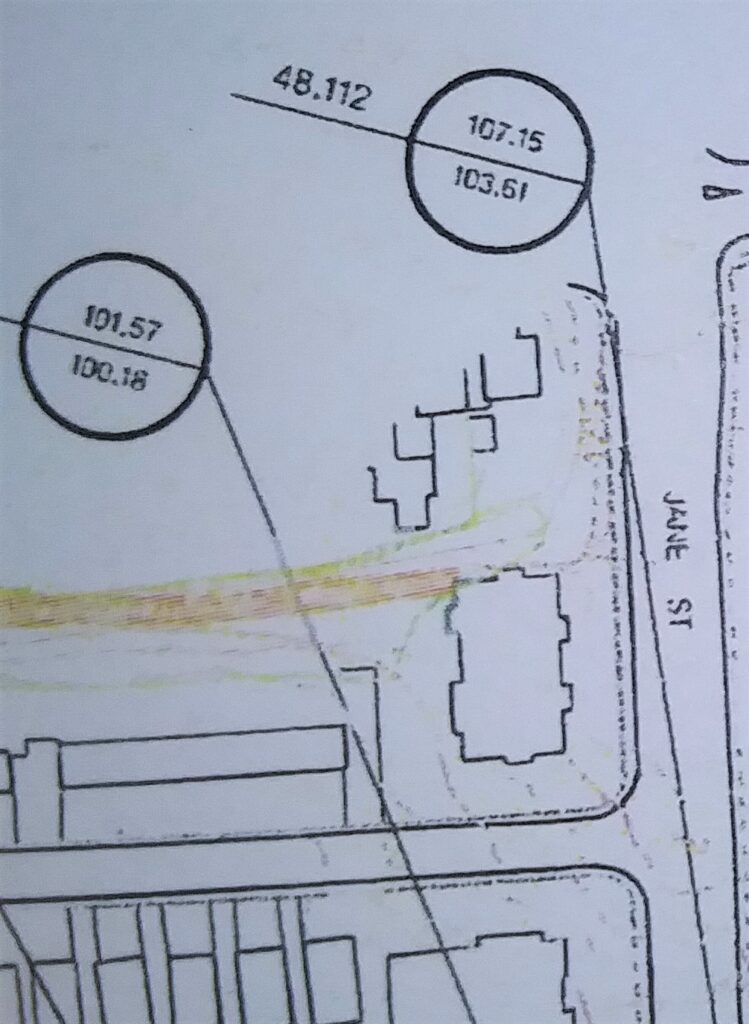Black Creek is a tributary of the Humber river, and much of the flooding in the Black Creek valley is a function of the water levels in the Humber valley, and the capacity of the Humber Sanitary Trunk Sewer (STS).
The linked pages discuss in greater detail the sanitary trunk sewers, and the municipal infrastructure. This page establishes some common factors and some history.
Black Creek is described as ‘flashy’, not because it wears bling, but because
1. Urbanization now reaches north to the headwaters of the creek
2 Channelization of the creek bed from Highway 7 south.
These combine to allow storm water that falls in the headwaters to reach Mount Dennis at about the same time that the storms, typically coming from the north west, arrive here. In bygone days, the storm water arrived later, spread over a longer period of time, and with lower peak flows.
Flood levels are described in elevation above sea level. Lake Ontario is about 76 meters above sea level, and Black Creek at York University about 206. At Jane Street in dry weather, the creek is at 100.18m. During a major event, to the west in Smythe Park, water rises about 1.5m to about the same level as the Humber River west of Scarlett Road, at about 101 metres.
Strangely, the Jane culvert was not only built at a higher elevation than the park, but it also was undersized and increasingly restricts flow. Water levels in major events can reach to over 107m on the upstream side. Simply put, the water is 18 feet deeper because of the culvert!

In July 2013, this created a lake that essentially reached back to Eglinton Avenue, since flow at Lavender Creek, and also under Weston Road, are reduced. Tonks Arena was flooded and the roadway for the new bridge connecting the rec centre was washed away.
To further complicate things, Weston, York, and Toronto were all built with combined sewers, essentially two channels sharing a larger tunnel, and when either channel experiences a surge, in can overflow within the tunnel. The mixed storm water and sewage run into the creek. Sounds simple enough, but unfortunately, the local sanitary sewers discharge into the Black Creek Sanitary Trunk Sewer (STS), and ultimately into the Humber STS. Bad enough that the rivers and lake get filled with sewage, but due to some bad design, the pipes that connect our local sanitary sewers are below the high water level of the creek. Before, during, and after storms, water from the creek runs into the sanitary trunk sewer through the ‘overflow‘. The creek level is meters above the STS, so the STS is under considerable pressure, and that pressure blows off the manhole covers on the trunk sewers allowing sewage onto local streets. That same pressure, enough to blow off the manhole covers, also forces sewage back into local sanitary drains and then into our basements. The pressure has been extreme enough to rupture the backwater valves the City urges residents to install.
Because the trunk sewer is surcharged here, it does not allow homes as far north as Finch Avenue to drain, so the issues here are not confined to ‘300 buildings on the floodplain’ as described in some city documents. The surcharged Black Creek sanitary sewer affects tens of thousands of residences, including high rise apartment buildings, as well as many businesses.
MDCA has learned of high rise residents in other cities forced from their apartments by mold when their buildings suffered basement flooding that paralyzed the ventilation system and led to mold. Damage is not limited to house basements in the floodplain.
Toronto is now studying basement flooding for the entire city!
There have been three environmental assessments starting in 2009. The original TRCA study is now being repeated since it has become outdated. That original study recommended replacing the Jane culvert a decade ago, but no action was taken.
Financed by the federal government, an engineering study based on the 2009-2014 TRCA study proposed the solutions that are under EA review now, and if all those solutions are implemented, will be a major factor in eliminating riverine flooding in Mount Dennis and reducing basement flooding in the Black Creek Sewershed. However, the City of Toronto studies indicate that the sanitary trunk sewer will continue to surcharge as no increases in sanitary trunk sewer capacity is in the budget, so basement flooding for Toronto is a long way from being addressed.